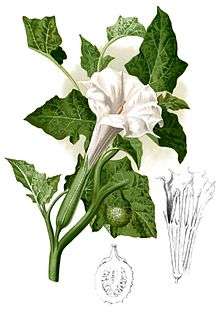Datura metel
| Datura metel | |
|---|---|
 | |
 | |
| 'Fastuosa' | |
| Scientific classification | |
| Kingdom: | Plantae |
| (unranked): | Angiosperms |
| (unranked): | Eudicots |
| (unranked): | Asterids |
| Order: | Solanales |
| Family: | Solanaceae |
| Genus: | Datura |
| Species: | D. metel |
| Binomial name | |
| Datura metel L. | |
Datura metel is a shrub-like perennial herb, commonly known as devil's trumpet and metel.
Datura metel grows in the wild in all the warmer parts of the world, such as India and is cultivated worldwide for its chemical and ornamental properties. It was first described by Linnaeus in 1753, but no botanically correct illustrations or descriptions were made until after the New World was settled. It is not possible to be sure about its original home.[1]
The plant is an annual herb growing up to 3 ft. high. It is slightly furry, with dark violet shoots and oval to broad oval leaves that are often dark violet as well. The pleasantly-scented 6-8 in. flowers are immensely varied, and can be single or double. Colors range from white to cream, yellow, red, and violet. The seed capsule is covered with numerous conical humps and a few spines.[1] It is similar to D. inoxia, but D. metel has almost glabrous leaves and fruits that are knobby, not spiny. D. inoxia is pilose all over and has a spiny fruit.
Medicinal use
Datura metel is one of the 50 fundamental herbs used in traditional Chinese medicine, where it is called yáng jīn huā (洋金花). However, the ingestion of D. metel in any form is dangerous and should be treated with extreme caution.
Toxicity
All parts of Datura plants contain dangerous levels of tropane alkaloids (highly poisonous) and may be fatal if ingested by humans or other animals, including livestock and pets. In some places, it is prohibited to buy, sell or cultivate Datura plants.[1]
Datura metel may be toxic if ingested in a tiny quantity, symptomatically expressed as flushed skin, headaches, hallucinations, and possibly convulsions or even a coma. The principal toxic elements are tropane alkaloids. Ingesting even a single leaf can lead to severe side effects.
Black daturas (Datura metel 'Fastuosa')

A cultivar of D. metel with a polished-looking ebony-black stem exists as a garden plant. Its flowers normally have a double or triple corolla, each corolla having a deep purple exterior and white or off-white interior. The plant is already reported to have become naturalised in Israel (see illustration). The black cultivar might become a common roadside dweller, like its white-flowered ancestor.
It is known under several cultivar names such as 'Black', 'Blackcurrant Swirl', 'Cornucopaea', 'Double Blackcurrant Swirl', 'Double Purple', and 'Purple Hindu'. It has also received many scientific names which should not be used for a cultivar:
- Datura hummatu var. fastuosa (L.) Bernh.
- Datura fastuosa L.
- Datura metel f. fastuosa (L.) Danert
- Datura metel var. fastuosa (L.) Saff.
- Stramonium fastuosum (L.) Moench
Botanical description
The plant has the following characteristics:[2]
- Habit - Large, erect and stout herb
- Root - Branched tap root system
- Stem - The stem is hollow, green and herbaceous with strong odour
- Leaf - Simple, alternate, petiolate, entire or deeply lobed, glabrous showing unicostate reticulate venation and exstipulate.
- Inflorescence - Solitary and axillary cyme
- Flower - Large, greenish white, bracteate, ebractiolate, pedicellate, complete, dichlamydeous, pentamerous, regular, actinomorphic, bisexual, and hypogynous
- Calyx - Sepals 5, green, gamosepalous showing valvate aestivation. Calyx is mostly persistent and odd sepal is posterior in position.
- Corolla - Petals 5, greenish white, gamopetalous, plicate showing twisted aestivation, funnel shaped with wide mouth and 10-lobed.
- Androecium - Stamens 5, free from one another, epipetalous, alternate the petals and are inserted inside the middle of the corolla tube. Anthers are basifixed, dithecous with long filament, introrse and longitudinally dehiscent.
- Gynoecium - Ovary superior, syncarpous and bicarpellary. Ovary is basically bilocular but tetralocular due to false septa. Carpels are obliquely place and ovules on swollen axile placenta. Style simple, long and filliform. Stigma is two lobed.
- Fruit - Spinescent capsule opening by four apical valves with persistent calyx.
- Seed - Endospermous
References
External links
 Media related to Datura metel at Wikimedia Commons
Media related to Datura metel at Wikimedia Commons- USDA Germplasm Resources Information Network (GRIN): Datura metel L.
- Poisonous Plants of North Carolina: Datura Metel